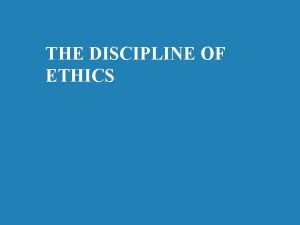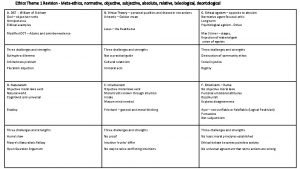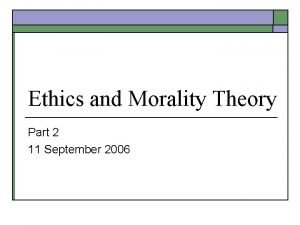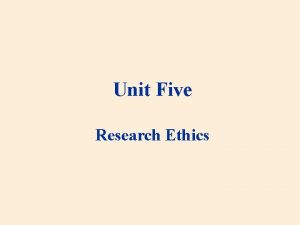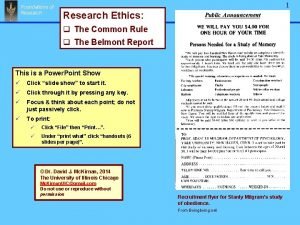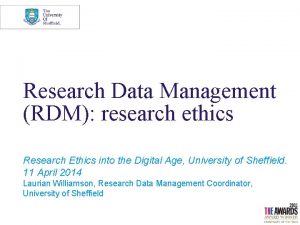Ethics In Research Directions Your group is the








- Slides: 8

Ethics In Research



Directions: Your group is the Animal Care Committee for a university. It is the committee’s responsibility to evaluate and either approve or reject research proposals submitted by faculty members who want to use animals for research or instructional purposes in psychology, biology, or medicine. The proposals describe the experiments, including the goals and potential benefits of the research as well as any discomfort or injury that they may cause the animal subjects. You must either approve the research or deny permission for the experiments. It is not your job to suggest improvements on technical aspects of the projects, such as the experimental design. You should make your decision based on the information given in the proposal.

CASE 1 Professor King is a psychobiologist working on the frontiers of a new and exciting research area of neuroscience called brain grafting. Research has shown that neural tissue can be removed from the brains of monkey fetuses and implanted into the brains of monkeys that have suffered brain damage. The neurons seem to make the proper connections and are sometimes effective in improving performance in brain-damaged animals. These experiments offer important animal models for human degenerative diseases such as Parkinson’s and Alzheimer’s. Professor King wants to transplant tissue from fetal monkey brains into the entorhinal cortex of adult monkeys; this is the area of the human brain that is involved with Alzheimer’s disease. The experiment will use 20 adult rhesus monkeys. First, the monkeys will be subjected to ablation surgery in the entorhinal cortex. This procedure will involve anesthetizing the animals, opening their skulls, and making lesions using a surgical instrument. After they recover, the monkeys will be tested on a learning task to make sure their memory is impaired. Three months later, half of the animals will be given transplant surgery. Tissue taken from the cortex of monkey fetuses will be implanted into the area of the brain damage. Control animals will be subjected to sham surgery, and all animals will be allowed to recover for two months. They will then learn a task to test the hypothesis that the animals having brain grafts will show better memory than the control group. Professor King argues that this research is in the exploratory stages and can only be done using animals. She further states that by the year 2000 about 2 million Americans will have Alzheimer’s disease and that her research could lead to a treatment for the devastating memory loss that Alzheimer’s victims suffer.

CASE 2 Dr. Fine is a developmental psychobiologist. His research concerns the genetic control of complex behaviors. One of the major debates in his field concerns how behavior develops when an animal has no opportunity to learn a response. He hypothesizes that the complex grooming sequence of mice might be a behavior pattern that is built into the brain at birth, even though it is not expressed until weeks later. To investigate whether the motor patterns involved in grooming are acquired or innate, he wants to raise animals with no opportunity to learn the response. Rearing animals in social isolation is insufficient because the mice could teach themselves the response. Certain random movements could accidentally result in the removal of debris. These would then be repeated and could be coordinated into the complex sequence that would appear to be instinctive but would actually be learned. To show that the behaviors are truly innate, he needs to demonstrate that animals raised with no opportunity to perform any grooming-like movements make the proper movements when they are old enough to exhibit the behavior. Dr. Fine proposes to conduct the experiment on 10 newborn mice. As soon as the animals are born, they will be anesthetized and their front limbs amputated. This procedure will ensure that they will not be reinforced for making random grooming movements that remove debris from their bodies. The mice will then be returned to their mothers. The animals will be observed on a regular schedule using standard observation techniques. Limb movements will be filmed analyzed. If grooming is a learned behavior, then the mice should not make grooming movements with their stumps as the movements will not remove dirt. If, however, grooming movements are innately organized in the brain, then the animals should eventually show grooming like movement with the stumps. In his proposal, Dr. Fine notes that experimental results cannot be directly applied to human behavior. He argues, however, that the experiment will shed light on an important theoretical debate in the field of developmental psychobiology. He also stresses that the amputations are painless and the animals will be well treated after the operation.

CASE 3 Your university includes a college of veterinary medicine. In the past, the veterinary students have practiced surgical techniques on dogs procured from a local animal shelter. However, there have been some objections to this practice, and the veterinary school wants the approval of your committee to continue this practice. They make the following points. 1. Almost all of these animals will eventually be killed at the animal shelter. It is wasteful of life to breed animals for the vet school when there is an ample supply of animals that are going to be killed anyway, either because their owners do not want them or because they are homeless. 2. It costs at least 10 times as much to raise purebred animals for research purposes; this money could be better used to fund research that would benefit many animals. 3. Research with dogs from animal shelters and the practice surgeries will, in the long run, aid the lives of animals by training veterinarians and producing treatments for diseases that afflict animals. A local group of animal welfare activists has urged your committee to deny the veterinary school’s request. They argue that the majority of these animals are lost or stolen pets, and it is tragic to think that the dog you have grown to love will wind up on a surgical table or in an experiment. Furthermore, they claim that as people become aware that animals taken to shelters may end up in research laboratories, they will stop using the shelters. Finally, the activists point out that in countries such as England, veterinary students do not perform practice surgery; they learn surgical techniques in an extensive apprenticeship.

CASE 4 The Psychology Department is requesting permission from your committee to use 10 rats per semester for demonstration experiments in a physiological psychology course. The students will work in groups of three; each group will be given a rat. The students will first perform surgery on the rats. Each animal will be anesthetized. Following standard surgical procedures, an incision will be made in the scalp and two holes drilled in the animal’s skull. Electrodes will be lowered into the brain to create lesions on each side. The animals will then be allowed to recover. Several weeks later, the effects of destroying this part of the animal’s brain will be tested in a shuttle avoidance task in which the animals will learn when to cross over an electrified grid. The instructor acknowledges that the procedure is a common demonstration and that no new scientific information will be gained from the experiment. He argues, however, that students taking a course in physiological psychology must have the opportunity to engage in small animal surgery and to see firsthand the effects of brain lesions.

